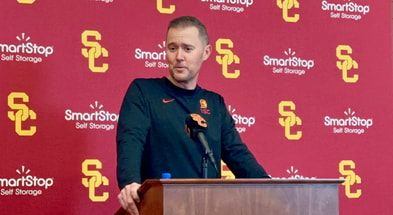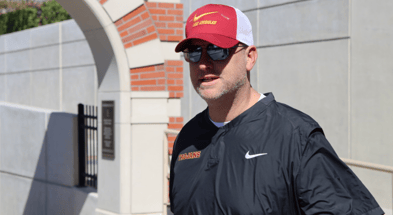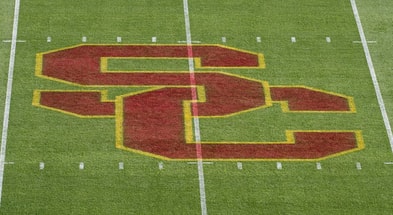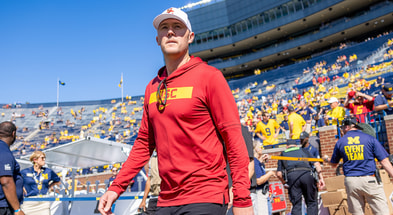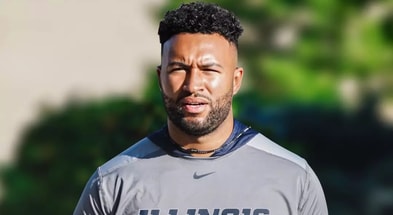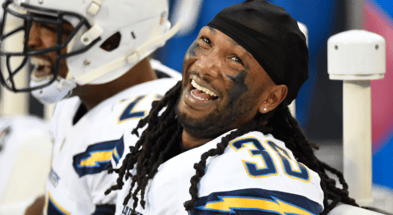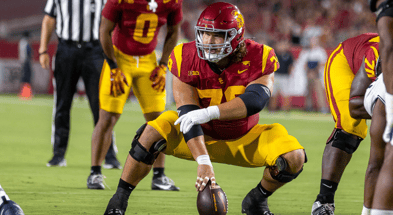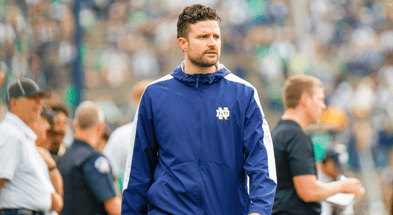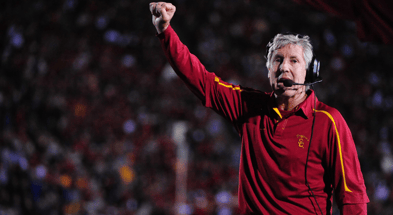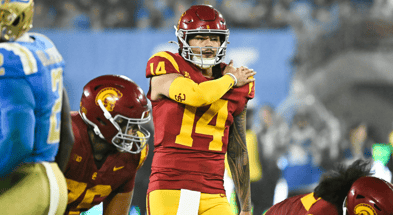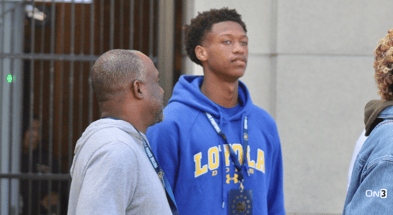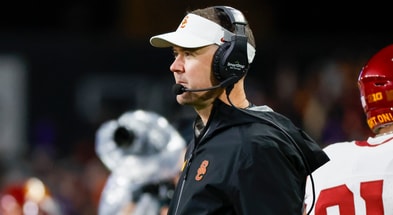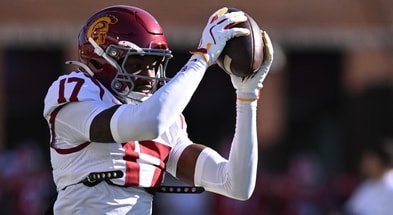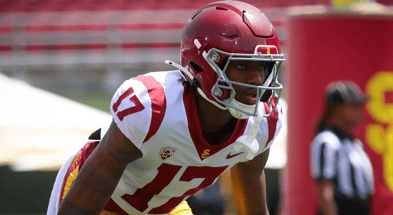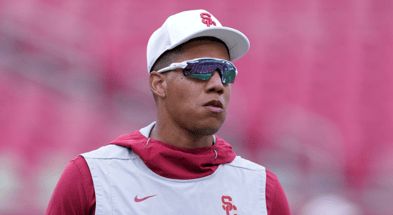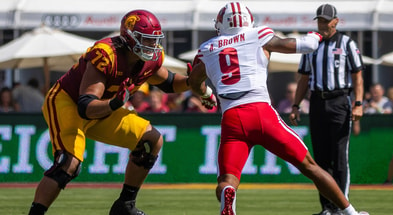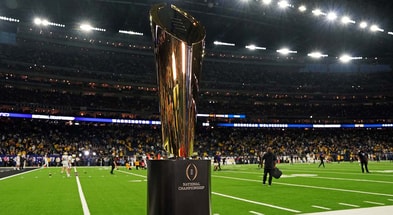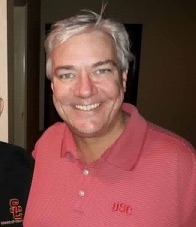Musings from Arledge: The USC Defense

“It used to be that good defense beats good offense. Good defense doesn’t beat good offense anymore…. It used to be if you had a good defense, other people weren’t going to score. You were always going to be in the game. I’m telling you. It ain’t that way anymore.”
— Nick Saban
I want to look at the USC defense over the first half of the season, and I think you must start any assessment with any understanding that college football has changed dramatically, as Nick Saban’s quote makes clear. Scoring has been climbing steadily for decades now. In 1980, the average points per game was just over 20. By 2020, it was just over 30. That’s obviously a 50% increase, and it’s equal to roughly three additional touchdowns per game.
This difference shows when you compare teams from different eras. The 1979 USC national championship team — a team with two eventual Heisman winners, and dozens of future NFL players, including four future NFL Hall of Famers — scored 32.4 points per game. Clay Helton’s very average USC team forty years later went 8-5 and averaged 32.5 points per game.
I start with this because coaches know now that their defenses will give up yards and points. Georgia had one of the great defenses in modern memory last year. It was a group fall of future NFL stars. Even they gave up 41 points to Alabama in the SEC championship game.
Part of the reason for this is rule changes over time. Offensive linemen can be a couple of yards downfield on run-pass option plays, which puts defenses in a real bind. Defensive backs can’t breathe on a receiver without getting a pass interference call. And rules designed to protect players from serious head injuries have made it very difficult to intimidate offensive players; you can’t take a receiver’s head off when he runs across the middle anymore. Rules changes have been a major factor.
Another part of the scoring splurge has been the increasing sophistication of offenses. In the early 80’s, Bill Walsh changed offensive football forever with his west coast passing game. Before Walsh, even the best quarterbacks had completion percentages in the low 50’s and touchdown-to-interception ratios of around 1:1. Building on Walsh, Hal Mumme invented the air raid, and all kinds of spread formations have made it easier to pass and run. Modern offenses do a much better job of getting athletes in space, where a missed tackle can mean a big gain or even a touchdown.
Watching the 1967 USC-UCLA game last year for the first time, I was struck by how USC really struggled to get its elite athletes — OJ and Earl McCullooch — in space. In a modern spread offense, USC would not have scored only 21 points with that talent.
So the question is, what can modern defenses do? Teams that have excellent pass rushers up front can continue to play zone defense, keep everything in front, and get the secondary involved stopping the run. But if you don’t have the luxury of having elite pass rushers, this old-school strategy of playing it safe and waiting for the other team to make a mistake is usually a disaster.
The answer, I think, is to play very aggressively on defense. Stunt, blitz, do what you must to get to the passer. Teach your players to strip the ball. Aggressively jump routes for interceptions. The downside to this strategy is that your defense will give up big plays; aggressive defenses get burned. But if you’re going to give up points anyway — and against the good teams, you almost always will — you’re better off attacking. In the days of explosive offenses, an early interception and drive-killing sack can lead to an early 21-0 lead.
This is essentially the style of play that Alex Grinch has used most of this season. He does not have a lot of top-end pass rushers, so he aggressively uses stunts and blitzes to generate pressure through scheme. And it’s worked, for the most part. Even against Utah (not a fun defensive performance), had the officials not called an inexcusable roughing-the-passer penalty the second Utah drive, Calen Bullock’s interception in the end zone probably would have led to a 21-0 lead, and USC would still be undefeated today.
Still, the defense has had long stretches where it is frustrating to watch. The reason, I think, is because the defense is relying almost entirely on big plays to stop the opposing offense. During stretches where it is not generating big plays, the defense is in trouble.
Right now, USC is No. 56 in the country in yards per game, No. 70 in yards per play, and No. 93 in yards per rush attempt. Those obviously aren’t great numbers. But because USC is tied for No. 6 in takeaways per game, tied for No. 7 in sacks per game, and tied for No. 30 in tackles for loss per game, the defense has managed to come in at an almost-reasonable No. 41 in scoring defense (22.14 per game).
By the way, those sack and tackles for loss numbers hide another story. Alex Grinch’s defense relies heavily on penetration from the defensive front to stop the running game. And I think what we’re seeing is apart from sacks, the tackles for loss numbers are very pedestrian. This would explain why the yards per rush numbers are so bad. The defense has generated sacks, mostly with stunts and other aggressive ways to generate heat on the quarterback, but when it simply comes down to defensive linemen beating blocks and getting in the backfield, USC isn’t very good.
Top 10
- 1
Rick Pitino
New sheriff in Big Ten?
- 2
Ryan Day
Buyout revealed from new contract
- 3
UNC president
Belichick hire fall out
- 4
'I'm 1-0 vs. PETA'
La. Gov. defends LSU live tiger
- 5
2025 CFB odds
Key game point spreads
Get the On3 Top 10 to your inbox every morning
By clicking "Subscribe to Newsletter", I agree to On3's Privacy Notice, Terms, and use of my personal information described therein.
Bottom line: the defense has made huge gains since last year, when USC played the worst defense I’ve ever seen at the university. Not surprisingly, there is still a ways to go. USC got some top-notch talent in the transfer portal – Eric Gentry and Mekhi Blackmon, especially – but it did not get nearly the same level of talent on that side of the ball that it got on offense. The Trojans need a major influx of defensive talent in the transfer portal this year, particularly up front.
Do I owe Clay Helton an apology?
No.
Wait, you were expecting more? Okay. Clay Helton has had a very good first year at Georgia Southern. Maybe he’s learned some things. Maybe this is the right fit for him. Maybe – my guess – his special brand of hugs and low expectations takes a while to ruin a program. Time will tell. In any event, congrats to Clay on a much better bounce-back season than I anticipated.
That wasn’t the only thing I was wrong about. I actually started to believe in UCLA. I should have known better. They just delayed the inevitable Bruin collapse for a few extra weeks this year.
Maybe. Or maybe it’s just really tough to play on the road. I’m not convinced UCLA loses to Oregon at a neutral site. Just like I am convinced that USC handles Utah at a neutral site. Road games at loud venues against good teams are difficult. Ask Alabama, which gave up 52 points at Rocky Top two weeks ago.
The Bruins are still good and will still be a major threat next month. I still expect both teams to score in the 40’s.
This might be an unpopular opinion, but what was with the Oregon uniforms against UCLA? Black with pink trim? Even assuming it’s important to highlight breast cancer, whatever happened to wearing your school colors and then highlighting with shoes or towels or something?
Also – honest question – when college teams like Oregon go with the pink alternative uniform, does the uniform choice come as some sort of broader financial commitment to fighting breast cancer? I hope so. I’ve had very close relatives get breast cancer; I understand how awful it is. Money for treatment or research is a very good thing. I’ve tried to find information on the internet about whether Oregon’s Stomp Out Cancer uniforms were part of a money-raising strategy, and I haven’t found an answer. Does anybody know? If the uniform choice is just “raising awareness,” is there really anybody in America who isn’t already “aware” of breast cancer?
——–
USC now starts the portion of the schedule where the team gets on a roll, the younger guys get some experience, and the team climbs in the polls without doing much. Three weeks of that before the massive three-week close to the season: UCLA, Notre Dame, and either Oregon or Utah in the conference championship game. Those last three games will decide whether this is a good start on Lincoln Riley’s turnaround or a monster season that shows USC is back amongst the elite. Can’t wait.

